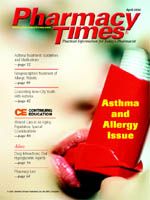Publication
Article
Pharmacy Times
A Point About Levothyroxine
Practitioner confusion about decimal- point placement with levothyroxine doses is a commonly reported problem. Frequently we hear about errors where prescribers have ordered levothyroxine 0.25 mg instead of the correct dose of 0.025 mg. Imagine what the consequences would be if an elderly patient with a cardiac condition accidentally received 10 times the intended dose of levothyroxine. Conversion of the dose from micrograms to milligrams is another source of error. Mathematical errors and decimal- point misplacement have been reported often, especially when the conversion occurred mentally.
Because errors are so common with this drug, 1 pharmacist told us that he has set his computers to signal an alert whenever a 0.25 mg dose is entered. When the warning appears, the correct dose almost always has been 0.025 mg. This pharmacist also told us that he received a prescription for levothyroxine 0.75 mg PO daily. Upon checking the patient's drug history, he noticed that the patient had been taking 0.075 mg. Whereas someone with experience may realize that 0.75 mg is an excessive amount, orders for 0.25 mg could slip by more easily. After all, levothyroxine is available in a 0.3 mg tablet strength, although Drug Facts and Comparisons states that the dose for hypothyroidism rarely should exceed 0.2 mg.
Safe Practice Recommendations
Clinicians need to be alerted to the risks associated with dosing this product and have pharmacists or nurses at community, ambulatory, or long-term care sites provide feedback directly to prescribers if an excessive dose is suspected. In order to avoid decimal points and dose conversions, health care practitioners should express the dose in the same way that most manufacturers express the dose?in micrograms, not milligrams. When abbreviating the word microgram, avoid using the Greek letter character "?" for "micro" because it can look like an "m," which could be misunderstood as milligram. The safest abbreviation to use for microgram is "mcg."
The Institute for Safe Medication Practices recently asked the FDA to require that all levothyroxine manufacturers state the dose in micrograms on their labels (currently this practice is not required). In pharmacies or at practice sites where computerized prescribing is used, systems should be programmed to alert staff members if the dose exceeds 200 mcg (0.2 mg) daily. In pharmacies, consider shelf labels to remind staff members to check when doses greater than 0.2 mg are prescribed. In addition, due to the wide range of available levothyroxine doses, health care practitioners always should be alert to the possibility of numbers looking like each other (ie, the numbers 7, 1, and 2, when poorly written, could be misinterpreted).
Pharmacists also should educate patients regarding the expected tablet appearance. As long as patients continue on the same dose, the tablet usually should remain the same color.
Subscribe to Newsletter Pharmacy Times and the Institute for Safe Medication Practices (ISMP) would like to make community pharmacy practitioners aware of a publication that is available.
The ISMP Medication Safety Alert! Community/Ambulatory Care Edition is a monthly compilation of medication- related incidents, error-prevention recommendations, news, and editorial content designed to inform and alert community pharmacy practitioners to potentially hazardous situations that may affect patient safety. Individual subscription prices are $45 per year for 12 monthly issues. Discounts are available for organizations with multiple pharmacy sites. This newsletter is delivered electronically. For more information, contact ISMP at 215-947-7797, or send an e-mail message to community@ismp.org.
Report Medication Errors
The reports described here were received through the USP Medication Errors Reporting Program, which is presented in cooperation with the Institute for Safe Medication Practices (ISMP). ISMP is a nonprofit organization whose mission is to understand the causes of medication errors and to provide time-critical error-reduction strategies to the health care community, policy makers, and the public. Throughout this series, the underlying system causes of medication errors will be presented to help readers identify system changes that can strengthen the safety of their operation.
If you have encountered medication errors and would like to report them, you may call ISMP at 800-324-5723 (800-FAILSAFE) or USP at 800-233- 7767 (800-23-ERROR). ISMP's Web address is www.ismp.org.







